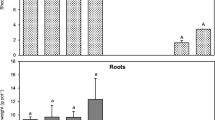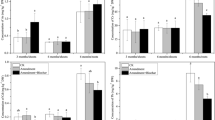Abstract
Phytoremediation is an attractive, economic alternative to soil removal and burial methods to remediate contaminated soil. However, it is also a slow process. The effect of humic acid in enhancing B and Pb phytoextraction from contaminated soils was studied (pot experiment) using transplanted vetiver grass (Vetiveria zizanioides (L.) Nash). Boron was applied at 0, 45, 90 and 180 kg B ha−1 soil (as H3BO3) in 16 replicates. Of the 64 pots, four pots each were treated with 0, 100, 200 and 400 kg ha−1 humic acid (HA) solution. In a separate experiment, Pb was applied (as Pb(NO3)2) at 0, 45, 90 and 180 kg Pb ha−1 prior to addition of HA solutions at levels identical to the B experiment. Experiments were conducted using a randomized complete block design with four replicates. Vetiver grass was harvested 90 days after planting. Lead addition beyond 45 kg Pb ha−1 decreased Pb uptake mostly due to a yield decline. Humic acid application increased Pb availability in soil and enhanced Pb uptake while maintaining or enhancing yield. An application of 200 kg HA ha−1 was optimal for maintaining yield at elevated Pb levels. Boron application did not impact yield but greatly increased B content of roots and shoot. Boron uptake was greatest upon addition of 400 kg HA ha−1. We conclude that HA addition to vetiver grass can be an effective way to enhance phytoremediation of B and Pb but optimum rates differ depending on soil B and Pb contamination levels.



Similar content being viewed by others
References
Angin, I., & Turan, M. (2004). Phytoremediation (a review). In International soil congress (ISC) on natural resource management for sustainable development. Erzurum, Turkey: Soil Science Society of Turkey, Atatürk University, June.
AOAC (Association of Official Analytical Chemists-International) (1990). Official methods of analysis (15st ed.). Arlington, VA: AOAC-Int.
Atiyeh, R. M., Lee, S., Edwards, C. A., Arancon, N. Q., & Metzger, J. D. (2002). The influence of humic acids derived from earthworm processed organic wastes on plant growth. Bioresource Technology, 84, 7–14.
Bama, K. S., & Selvakumari, G. (2005). Effect of humic acid and fertilizers on yield and nutrition of rice in alfisol. Journal of Ecobiology, 17(1), 41–47.
Bingham, F. T. (1982). Boron. In A. L. Page, R. H. Miller, & E. D. Keeney (Eds.) Methods of soil analysis, Part II, chemical and microbiological properties ((pp. 431–448)2nd ed.). Madison, WI: ASA.
Bremner, J. M. (1996). Nitrogen-total. In D. L. Sparks (Ed.) Methods of soil analysis, Part III, chemical methods ((pp. 1085–1122)2nd ed.). Madison, WI: ASA.
Brun, L. A., Maillet, J., Hinsinger, P., & Pepin, M. (2001). Evaluation of copper availability in copper contaminated vineyards soils. Environmental Pollution, 111, 293–302.
Burau, R. E. (1982). Lead. In A. L. Page, R. H. Miller, & E. D. Keeney (Eds.) Methods of soil analysis, Part II, chemical and microbiological properties ((pp. 347–366)2nd ed.). Madison, WI: ASA.
Chantachon, S., Kruatrachue, M., Pokethitiyook, P., Upatham, S., Tantanasarit, S., & Soonthornsarathool, V. (2004). Phytoextraction and accumulation of lead from contaminated soil by vetiver grass: Laboratory and simulated field study. Water, Air, and Soil Pollution, 154, 37–55.
Chatterjee, J., & Chatterjee, C. (2000). Phytotoxicity of cobalt, chromium and copper availability in copper-contamianted vineyards soils. Environmental Pollution, 109, 69–74.
Chen, Y., & Aviad, T. (1990). Effects of humic substances on plant growth. In P. MacCarthy (Ed.) Humic substances in soil and crop sciences: Selected readings (pp. 161–186). Madison, WI: ASA.
Chen, H. M., Zheng, C. R., Tu, C., & Shen, Z. G. (2000). Chemical methods and phytoremediation of soil contaminated with heavy metals. Chemosphere, 41, 229–234.
Chen, Y., Shen, Z., & Li, X. (2004). The use of vetiver grass (Vetiveria zizanioides) in the phytoremediation of soil contaminated with heavy metals. Applied Geochemistry, 19, 1553–1565.
Choi, E.-Y., McNeill, A., Coventry, D., & Stangoulis, J. (2006). Whole plant response of crop and weed species to high subsoil boron. Australian Journal of Agricultural Research, 57, 761–770.
DIN (1995). Soil quality extraction of trace elements with ammonium nitrate solution. Berlin, Germany: Deutsch Institut fur Normung 19730.
Ensley, B. D. (2000). Rationale for use of phytoremediation. In I. Raskin, & B. D. Ensley (Eds.) Phytoremediation of toxic metals: Using plants to clean up the environment (pp. 3–12). Mississauga, ON, Canada: Wiley.
Evangelou, M. W. H., Daghan, H., & Schaeffer, A. (2004). The influence of humic acids on the phytoextraction of cadmium from soil. Chemosphere, 57, 207–213.
Evangelou, M. W. H., Ebel, M., & Schaeffer, A. (2007). Chelate assisted phytoextraction of heavy metals from soil. Effect, mechanism, toxicity, and fate of chelating agents. Chemosphere, 68, 989–1003.
Gee, G. W., & Bauder, J. W. (1986). Particle-size analysis. In A. Klute (Ed.) Methods of soil analysis, part I, physical and mineralogical methods ((pp. 383–441)2nd ed.). Madison, WI: ASA.
Herawati, N., Susuki, S., Hayashi, K., Rivai, I. F., & Koyama, H. (2000). Cadmium, copper and zinc levels in rice and soil of Japan, Indonesia, and China by soil type. Bulletin of Environmental Contamination and Toxicology, 64, 33–39.
Hofrichter, M., & Steinbüchel, A. (2004). Biopolymers. Vol. 1. Lignin, humic substances and coal. Weinheim, NY: Wiley Europe-VCH.
Kayser, A., Wenger, K., Keller, A., Attinger, W., Felix, H. R., Gupta, S. K., & Schulin, R. (2000). Enhancement of phytoextraction of Zn, Cd, and Cu from calcareous soil: The use of NTA and sulfur amendments. Environmental Science & Technology, 34, 1778–1783.
Kim, S. O., Moon, S. H., & Kim, K. W. (2001). Removal of heavy metals from soils using enhanced electro kinetic soil processing. Water Air and Soil Pollution, 125, 259–272.
Lagier, T., Feuillade, G., & Matejka, G. (2000). Interactions between copper and organic macromolecules: Determination of conditional complexation constants. Agronomie, 20, 537–546.
Li, H., Wang, Q., Cui, Y., Dong, Y., & Christie, P. (2005). Slow release chelate enhancement of lead phytoextraction by corn (Zea mays L.) from contaminated soil – A preliminary study. Science of the Total Environment, 339, 179–187.
Mackowiak, C. L., Grossl, P. R., & Bugbee, B. G. (2001). Beneficial effects of humic acid on micronutrient availability to wheat. Soil Science Society of America Journal, 65, 1744–1750.
McBride, M. S. (1994). Environmental chemistry of soils. New York: Oxford University Press.
McLean, E. O. (1982). Soil pH and lime requirement. In A. L. Page, R. H. Miller, & E. D. Keeney (Eds.) Methods of soil analysis, part II, chemical and microbiological properties ((pp. 199–224)2nd ed.). Madison, WI: ASA.
Naidu, R., & Harter, R. D. (1998). Effect of different organic ligands on cadmium sorption by and extractability from soils. Soil Science Society of America Journal, 62, 644–650.
Nelson, D. W., & Sommers, L. E. (1982). Organic matter. In A. L. Page, R. H. Miller, & E. D. Keeney (Eds.) Methods of soil analysis, part II, chemical and microbiological properties ((pp. 574–579)2nd ed.). Madison, WI: ASA.
Norvell, W. A. (1991). Reactions of metal chelates in soils and nutrient solutions. In J. J. Mortvedt (Ed.) Micronutrients in agriculture (pp. 187–2272nd ed.). Madison, WI: SSSA Book Series No. 4.
Olsen, S. R., Cole, C. V., Watanabe, F. S., & Dean, L. A. (1954). Estimation of available phosphorus in soils by extraction with sodium bicarbonate. USDA Circular 939, Washington, DC.
Qadir, M., Steffens, D., Yan, F., & Schubert, S. (2003). Sodium removal from a calcareous saline-sodic soil through leaching and plant uptake during phytoremediation. Land Degradation & Development, 14, 301–307.
Rhoades, J. D. (1982). Cation exchange capacity. In A. L. Page, R. H. Miller, & E. D. Keeney (Eds.) Methods of soil analysis, part II, chemical and microbiological properties ((pp. 149–157)2nd ed.). Madison, WI: ASA.
Rhoades, J. D. (1996). Salinity: Electrical conductivity and total dissolved solids. In D. L. Sparks (Ed.) Methods of soil analysis, part III, chemical methods ((pp. 417–436)2nd ed.). Madison, WI: ASA.
SAS Institute Inc. (1999). SAS User’s Guide. SAS Inst., Cary, NC.
Schnoor, J. L. (1997). Phytoremediation. Ground-water remediation technologies analysis center; Technology Evaluation Report (TE-98-01), Iowa City, IO.
Soil Survey Staff (1992). Keys to soil taxonomy (5th ed.). Blacksburg, VA: SMSS Technical Monograph No: 19, Pocahontas Press Inc.
Soylu, S., Topal, A., Sade, B., Akgun, N., Gezgin, S., & Babaoglu, M. (2004). Yield and yield attributes as affected by boron application in boron-deficient calcareous soils: An evaluation of major Turkish genotypes for boron efficiency. Journal of Plant Nutrition, 27, 1077–1106.
Sumner, M. E., & Miller, W. P. (1996). Cation exchange capacity and exchange coefficients. In D. L. Sparks (Ed.) Methods of soil analysis, Part III, chemical methods ((pp. 1201–1230)2nd ed.). Madison, WI: ASA.
Truong, P. N., McDowell, M., & Christiansen, I. (1995). Stiff grass barrier with vetiver grass – A new approach to erosion and sediment control. In H. M. Hunter, A. G. Eyles, & G. E. Rayment (Eds.) Proceedings, Downstream Effects of Land Use National Conference, Rockhamton, Queensland, Australia, 26–28 April 1995 (pp. 301–304).
Turan, M., & Angin, I. (2004). Organic chelate assisted phytoextraction of B, Cd, Mo and Pb from contaminated soils using two agricultural crop species. Acta Agriculturæ Scandinavica Section B, Soil and Plant Science, 54, 221–231.
Turan, M., & Esringu, A. (2007). Phytoremediation based on canola (Brassisa napus L.) and Indian mustard (Brassica juncea L.) planted on spiked soil by aliquot amount of Cd, Cu, Pb and Zn. Plant Soil Environment, 1, 7–15.
USDA-NRCS (2000). Heavy metal soil contamination. Auburn, AL: Soil Quality Institute: Urban Technical Note No. 3.
Valdrighi, M. M., Pera, A., Agnolucci, M., Frassinetti, S., Lunardi, D., & Vallini, G. (1996). Effects of compost-derived humic acids on vegetable biomass production and microbial growth within a plant (Cichorium intybus) – Soil system: A comparative study. Agriculture, Ecosystems & Environment, 58, 133–144.
Wenger, K., Kayser, A., Gupta, S. K., Furrer, G., & Schulin, R. (2002). Comparison of NTA and elemental sulfur as potential soil amendments in phytoremediation. Soil & Sediment Contamination, 11, 655–672.
Wolf, B. (1972). Improvements in the Azomethine-H method for determining boron. Communications in Soil Science and Plant Analysis, 5, 39–44.
Zhang, X., Ervin, E. H., & Schmidt, R. E. (2003). Plant growth regulators can enhance the recovery of Kentucky bluegrass sod from heat injury. Crop Science, 43, 952–956.
Zhao, F., McGrath, S. P., & Crosland, A. R. (1994). Comparision of three wet digestion methods for the determination of plant sulphur by inductively coupled plasma emission spectrophotometry. Communications in Soil Science and Plant Analysis, 25, 407–418.
Acknowledgements
We thank Muhammet Kilci for supplying the vetiver seedlings for this study.
Author information
Authors and Affiliations
Corresponding author
Rights and permissions
About this article
Cite this article
Angin, I., Turan, M., Ketterings, Q.M. et al. Humic Acid Addition Enhances B and Pb Phytoextraction by Vetiver Grass (Vetiveria zizanioides (L.) Nash). Water Air Soil Pollut 188, 335–343 (2008). https://doi.org/10.1007/s11270-007-9548-0
Received:
Accepted:
Published:
Issue Date:
DOI: https://doi.org/10.1007/s11270-007-9548-0




